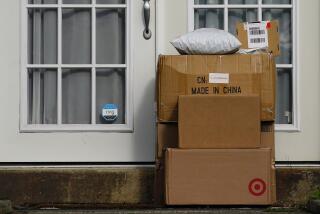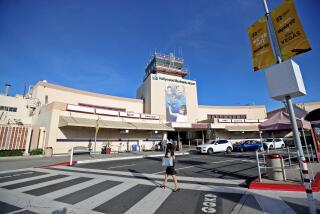Learning to Cope With the Lost-Luggage Blues
- Share via
Things to do today: 1. Go into your closet and cut leftover luggage tags from the handles of all suitcases. 2. Reach inside each suitcase and leave behind your home address and phone number. 3. Resolve that the next time an airline misplaces your luggage, you’ll have a clearer idea what to do about it.
Why this list? Consider these numbers just in from the U.S. Department of Transportation: During August, more than 224,000 passengers across the U.S. had their baggage mishandled.
It gets worse. The airline most likely to mishandle baggage--not only in August, but over the last two years--is the same carrier that dominates the runways at LAX: United Airlines.
United carried 14 million travelers to and from LAX last year, more than twice as many as any competitor. Mindful that many travelers on its shuttle service within California have been annoyed by tardy flights and crowded terminal areas, the airline’s top officials earlier this year vowed a new emphasis on customer service. Yet nationwide, in the 31 days of August, it misplaced more than 48,000 bags.
“We recognize that we have been behind,” acknowledged United spokesman Matthew Triaca. Since September, he said, the airline has been refocusing efforts and adding more baggage-scanning machines.
These figures don’t mean you should annoy your fellow passengers by trying to carry aboard all your possessions for that three-week winter trip. After all, among the 45 million Americans who flew in August, 201 of every 202 reported no baggage troubles. Even on United, 153 of every 154 travelers got their bags just fine.
But as U.S. carriers grapple with crowded flights, and as gate agents crack down on travelers with oversize carry-ons, it makes sense to know your options when luggage goes missing. Unless you ask, you may not be offered all the compensation you’re entitled to.
The first thing, of course, is preventive strategy: removing old tags and making sure your contact information is attached not only to the outside but also to the inside of each bag. Call to be sure your luggage meets the airline’s requirements for dimensions and weight. And bear in mind that code-sharing airlines often have different baggage policies, so if your trip involves more than one airline, you need to make more than one call.
At the airport, make sure the agent has given you a claim stub for each bag and tagged it properly. And if you think airline systems won’t misread tags, consider the case of Susie Cardone.
Cardone, who lives in Goleta, flew off to Hawaii on Delta Airlines to celebrate a late September anniversary with her husband, Brennon. On the way, Brennon’s suitcase vanished. For the rest of their eight-day trip, it never turned up.
“It was a nightmare,” says Susie, recalling frustrating negotiations to get compensation from Delta. Ultimately, she says, the couple got about $150, which Brennon used to buy clothes for his stay.
On returning home, the Cardones found a message on their answering machine. Brennon’s suitcase had spent the week at the Oxnard airport. In August, Susie had taken the bag on a United Express flight to Oxnard. Nobody had removed the old baggage tag, and one month later baggage handlers failed to notice that the tag had the wrong date, the wrong airline and the wrong destination. Off it went to Oxnard, despite the second tag that said Hawaii.
If your bag does arrive at the same airport you do, look at it closely. If you see any damage or sign of apparent theft, call the airline; make note of the exact time of the call and the full name of the representative to whom you speak. Follow up with a letter that restates key facts.
If your luggage arrives damaged, the DOT says, the airline will usually pay for repairs. But the airlines are protected by a federal limit on their luggage liability on domestic flights. That limit has been $1,250 for many years, but in their recent scramble to blunt customer criticism, the major airlines have asked federal officials to raise the limit to $2,500.
If you’re traveling with particularly valuable possessions, you can further protect yourself by buying travel insurance (which frequently covers not only lost but delayed bags), or by purchasing “excess valuation,” which is sometimes offered by airlines.
(On foreign flights the limits are similar: International law limits compensation for delayed, lost or damaged baggage to $20 per kilogram [$9.07 per pound]. Most international flights have a 70-pound checked-bag maximum, limiting compensation to about $640 per bag. If an international trip begins with a domestic flight--say, to New York, before a connection to Europe--both flights are considered international.)
If your luggage doesn’t turn up on the baggage carousel, find an airline representative to tell. Insist, no matter what soothing words the representative may utter about the next flight in, that you be allowed to fill out a lost-baggage form and keep a copy. Get a customer-service phone number where you can follow up. And if a long delay seems likely, be assertive in asking the airline to deliver the tardy baggage to wherever you’re staying.
If the luggage delay forces you to make purchases--of clothes, for instance--try to get the airline to pay as much of your expenses as possible, and save receipts.
Federal law doesn’t spell out airlines’ responsibilities while a bag is missing, so these cases come down to a judgment call by the airline staff--and negotiating by travelers. Some carriers compensate consumers after they produce receipts. Some offer a stipend ($50, for instance) for each day that your baggage fails to appear, but to get it, you have to call back daily.
To register a complaint with the DOT about airline baggage handling, telephone (202) 366-2220, e-mail [email protected] or write to Aviation Consumer Protection Division, U.S. Dept. of Transportation, Room 4107, C-75, Washington, DC 20590. Be sure to include your name, address, phone number, the nature of your problem and the specific flights, dates and airlines involved.
*
Christopher Reynolds welcomes comments and suggestions, but cannot respond individually to letters and calls. Write Travel Insider, Los Angeles Times, Times Mirror Square, Los Angeles 90053, or send e-mail to [email protected].
More to Read
Sign up for The Wild
We’ll help you find the best places to hike, bike and run, as well as the perfect silent spots for meditation and yoga.
You may occasionally receive promotional content from the Los Angeles Times.






